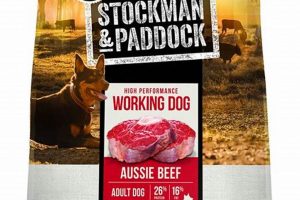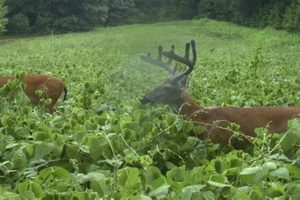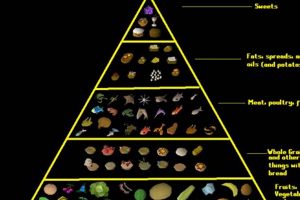The selection of effective bait is crucial for successful rodent capture within traps. This material acts as a lure, encouraging mice to interact with the trapping mechanism. Common examples include peanut butter, chocolate, and various seeds and grains.
Employing appealing bait improves trap efficacy, minimizing the duration of infestation. Historically, readily available household items were utilized, evolving to commercially produced attractants with enhanced appeal and longevity. The choice of a suitable material influences the speed and success of rodent control efforts.
Subsequent sections will examine specific characteristics of highly effective attractants, optimal placement strategies for traps, and complementary measures to enhance rodent control programs.
Tips for Selecting Effective Mouse Trap Lures
Optimizing trap success involves strategic choices in lure selection and application. The following tips offer guidance on enhancing rodent capture rates.
Tip 1: Prioritize High-Calorie Options: Mice are attracted to energy-rich foods. Peanut butter, chocolate spread, and nutella provide both enticing aromas and caloric content, enhancing their appeal.
Tip 2: Use Small Quantities: Excessive amounts of lure can allow mice to feed without triggering the trap. A pea-sized amount, firmly affixed to the trigger mechanism, is generally sufficient.
Tip 3: Employ Multiple Attractants: Rotation of lures prevents rodents from becoming accustomed to a single offering. A varied selection increases the likelihood of engagement.
Tip 4: Consider Nesting Materials: Cotton balls or dental floss, placed near traps, can serve as secondary attractants. Mice seeking nesting materials may inadvertently encounter the trapping mechanism.
Tip 5: Ensure Freshness: Stale or contaminated lures lose their effectiveness. Regular inspection and replacement of attractants is crucial for sustained success.
Tip 6: Secure the Bait: Properly securing the bait to the trap trigger mechanism is important. This forces the mouse to fully engage with the trap in order to get the bait, thus increasing the chances of a successful capture.
Tip 7: Consider Location: Place traps with lures in areas of high mouse activity, such as along walls, in dark corners, or near known food sources. The strategic placement amplifies the lure’s effectiveness.
Consistent application of these strategies can significantly improve the effectiveness of rodent trapping efforts, leading to quicker and more complete control of infestations.
The subsequent article sections will delve into trap placement strategies and sanitation protocols to create an integrated approach to rodent management.
1. Palatability
Palatability, referring to the degree to which a food is agreeable to the taste and texture preferences of a specific animal, is a primary determinant of bait effectiveness in rodent traps. If a mouse finds a substance unappetizing, it is unlikely to consume it, regardless of the substance’s other attractive properties. The direct cause-and-effect relationship is self-evident: high palatability leads to increased consumption and, consequently, a higher probability of the rodent triggering the trap mechanism.
The significance of palatability is evident in the widespread use of peanut butter. Its high fat and sugar content are naturally appealing to mice, and its relatively sticky texture encourages prolonged interaction with the trap. Conversely, if a readily available food source in the environment is more palatable than the trap bait, the trap’s effectiveness diminishes. For example, if a kitchen frequently has spilled grains and crumbs that are more appealing to the rodent, the trap bait’s palatability needs to match or exceed these competing food sources to ensure successful capture.
The practical application of this understanding requires careful observation of rodent behavior in the environment. Identifying their preferred food sources and matching or exceeding their palatability is crucial. Furthermore, considering factors like freshness and avoiding contaminated or stale baits ensures that the palatability remains high. A high palatability in your choice ensures that “best food for mouse traps” is realized, leading to effective control measures. This strategic approach directly contributes to the success of rodent control efforts.
2. Scent Attractiveness
Scent attractiveness plays a vital role in rodent lure efficacy. Olfactory cues are a primary means by which mice locate food sources, making the odor profile of the bait a critical factor in attracting them to traps.
- Diffusion Radius
The diffusion radius of a bait’s scent refers to the effective range over which the odor can be detected by a mouse. Highly volatile compounds, such as those found in peanut butter or chocolate, create a wider diffusion radius, increasing the likelihood of attracting rodents from a greater distance. This is crucial in environments where trap placement options are limited.
- Concentration Gradient
The concentration gradient of the scent influences the directionality of the mouse’s movement. A strong, consistent gradient guides the rodent towards the source, i.e., the trap. Infrequent bait replacement or the use of volatile baits can result in a weak or inconsistent gradient, reducing the trap’s appeal. A fresh supply of bait ensures a potent scent trail.
- Aversive Compounds
The presence of aversive compounds, even in trace amounts, can negate the attractiveness of an otherwise appealing scent. For example, residues from cleaning products or handling traps with scented lotions can introduce repellent odors. Thoroughly cleaning traps and using gloves when handling bait minimizes the risk of introducing these compounds.
- Scent Familiarity
In environments with persistent food odors, rodents may exhibit neophobia towards novel scents. Introducing small quantities of the bait near the trap site prior to setting the trap can help familiarize the rodents with the odor, increasing the likelihood of interaction once the trap is activated. This gradual acclimation can overcome initial hesitations.
Manipulating the scent profile of baits involves maximizing diffusion radius and concentration gradient while minimizing aversive compounds. Strategic scent attractiveness adjustments, such as pre-baiting and regular bait refreshment, greatly enhance the effectiveness of rodent control measures, optimizing the potential of “best food for mouse traps” strategies.
3. Bait Longevity
Bait longevity, the duration over which a bait remains attractive and effective, significantly influences trapping success. As it pertains to “best food for mouse traps”, it is not merely about initial allure but sustained appeal over time. A bait that quickly degrades, dries out, or becomes infested with insects loses its palatability and scent attractiveness, thereby nullifying its initial effectiveness.
Consider peanut butter, a commonly used bait. Its high oil content makes it appealing, but it can dry out and harden within a few days, especially in dry environments. This hardened substance loses its scent and becomes less enticing. Conversely, commercially produced rodent baits often incorporate preservatives and stabilizers to extend their shelf life and maintain their texture. The financial implications are also noteworthy. Frequent replacement of short-lived baits increases the operational costs of rodent control. Furthermore, a single trap failing due to degraded bait allows the rodent population to persist, prolonging the infestation and potentially leading to further property damage or health risks.
Therefore, selecting baits with inherent resistance to environmental degradation, coupled with regular inspection and replacement protocols, is paramount. Addressing bait longevity is not a secondary consideration but an integral factor in optimizing the efficacy and cost-effectiveness of rodent control strategies. Neglecting this aspect can undermine efforts, ultimately preventing the realization of “best food for mouse traps” benefits.
4. Texture Consistency
Texture consistency, or the uniformity of physical structure within a bait, directly influences a rodent’s willingness to interact with a trap. An inconsistent texture can trigger neophobia, causing rodents to avoid the bait, thereby diminishing trap effectiveness.
- Adherence to Trigger Mechanism
The texture of the bait must allow for effective adherence to the trap’s trigger mechanism. A too-crumbly or runny bait might detach easily, allowing the rodent to consume it without activating the trap. A firm, pliable texture ensures the rodent interacts directly with the trigger, increasing capture probability. Peanut butter’s stickiness, for instance, is a beneficial textural property in this regard.
- Mimicking Natural Food Sources
In some cases, rodents may exhibit preferences for textures similar to their natural food sources. For seed-eating rodents, a collection of small, uniform seeds might be more appealing than a large, amorphous blob of bait. Understanding the rodent’s dietary habits and matching the bait’s texture accordingly can enhance its attractiveness.
- Resistance to Environmental Change
Texture consistency should ideally be maintained under varying environmental conditions. A bait that liquefies in heat or hardens in cold becomes less attractive. Baits with inherent stability in texture offer a consistent stimulus, promoting continued interaction regardless of external factors.
- Discouraging Bait Theft
A bait with a firm, consistent texture is more difficult for rodents to steal and hoard. Loose or granular baits are easily carried away, reducing the opportunity for the rodent to trigger the trap. A texture that requires more deliberate manipulation for consumption increases the likelihood of a successful capture.
The selection of a bait exhibiting appropriate texture consistency enhances the overall effectiveness of trapping strategies. This is because it ensures reliable adherence to the trap, aligns with potential dietary preferences, resists environmental degradation, and discourages bait theft, all contributing to an increased likelihood of capture. The optimal “best food for mouse traps” choice considers these textural factors to maximize rodent interaction and trap activation.
5. Allergen Consideration
Allergen consideration, in the context of “best food for mouse traps”, represents a critical, often overlooked, aspect of integrated pest management. The selection of bait should extend beyond mere attractiveness to rodents; it must also account for potential allergenic responses in humans, particularly in residential environments. The cause-and-effect relationship is direct: employing a known allergen as bait can trigger reactions ranging from mild skin irritation to severe anaphylaxis in susceptible individuals. The importance of allergen consideration stems from the potential for indirect exposure through airborne particles, contaminated surfaces, or accidental ingestion by children or pets. A real-life example involves the widespread use of peanut butter. While highly effective as a rodent lure, peanut butter poses a significant risk to individuals with peanut allergies. Its presence, even in trace amounts, can elicit a severe allergic reaction, necessitating immediate medical intervention. Therefore, the “best food for mouse traps” cannot solely be defined by its rodent-attracting properties but must integrate safety considerations for all occupants of the treated environment.
Practical application of allergen consideration involves a thorough assessment of the environment and identification of potential allergy risks. Alternatives to common allergenic baits, such as sunflower seed butter or hypoallergenic synthetic attractants, should be explored and utilized whenever feasible. Clear labeling of traps with bait contents and strategic placement in areas inaccessible to children and pets further mitigates the risk of accidental exposure. In commercial or public spaces, where a diverse population with varying allergy profiles is present, heightened awareness and proactive selection of non-allergenic baits are paramount. Furthermore, communication with building occupants regarding the rodent control strategy and the types of baits being used can facilitate informed decision-making and proactive allergy management. Consideration of the local environment and inhabitants would greatly improve the definition of “best food for mouse traps.”
In summary, integrating allergen consideration into the selection process for rodent trap bait is essential for responsible and ethical pest management. By prioritizing the safety of all individuals who may be exposed to the bait, potential health risks can be minimized, and the overall effectiveness of the control strategy enhanced. While challenges may arise in identifying suitable alternatives that possess comparable attractiveness to allergenic baits, the benefits of protecting human health outweigh any marginal decrease in trap efficacy. The evolving landscape of pest management necessitates a holistic approach that incorporates environmental responsibility, ethical considerations, and, most importantly, human safety. By adhering to these principles, a more comprehensive and sustainable definition of “best food for mouse traps” can be achieved.
Frequently Asked Questions
This section addresses common inquiries regarding the most effective bait for mouse traps, offering guidance based on scientific principles and practical observations.
Question 1: Is cheese an effective bait for mouse traps?
While commonly depicted as a rodent attractant, cheese is not consistently effective as bait. Mice are often more attracted to foods with higher sugar or fat content, such as peanut butter or chocolate. The effectiveness of cheese can also be affected by its type and freshness.
Question 2: How much bait should be used in a mouse trap?
Excessive bait is counterproductive. A small, pea-sized amount, firmly affixed to the trigger mechanism, is typically sufficient. Too much bait may allow the rodent to feed without activating the trap.
Question 3: Should bait be refreshed regularly?
Regular bait refreshment is essential. Baits can dry out, become stale, or attract insects, diminishing their effectiveness. Replacing bait every few days, or sooner if visibly compromised, maintains its attractiveness.
Question 4: Are commercially available rodent baits more effective than household items?
Commercially available baits often contain ingredients specifically formulated to attract rodents, as well as preservatives to extend their shelf life. While household items can be effective, commercial baits typically offer a more consistent and potent attractant.
Question 5: Does varying the type of bait improve trapping success?
Varying the type of bait can prevent rodents from becoming accustomed to a single offering. Rotating between different attractive substances, such as peanut butter, chocolate, and seeds, can maintain their interest and improve trapping rates.
Question 6: Can the presence of alternative food sources affect bait effectiveness?
The presence of readily available alternative food sources can significantly reduce bait effectiveness. Removing or securing alternative food sources, such as spilled pet food or uncovered garbage, increases the likelihood that rodents will be drawn to the trap bait.
In summary, strategic bait selection and maintenance are crucial for successful rodent trapping. The information provided here offers a foundation for informed decision-making in rodent control efforts.
The subsequent section will explore trap placement strategies to further enhance rodent control measures.
Conclusion
The preceding analysis underscores the critical role of bait selection in effective rodent management. Factors such as palatability, scent attractiveness, longevity, texture consistency, and allergen considerations all contribute significantly to trapping success. Therefore, the selection of appropriate attractants demands a comprehensive understanding of rodent behavior and environmental context.
The consistent application of informed bait selection strategies is essential for minimizing rodent populations and mitigating associated risks. Continued research and refinement of these practices will further enhance the efficacy of rodent control efforts, safeguarding public health and property.







